Just as the music streamer market began expanding beyond the realm of esoteric high-end components, WiiM burst on the scene and disrupted everything. With basic music streamers starting under $100, the company has shown that high quality digital music streaming doesn’t require a massive investment. Over time, the company has evolved into producing higher-performance streaming devices with greater capabilities and more advanced features.
Until now, WiiM’s “pièce de résistance” was the WiiM Ultra, a solidly built budget streamer with a high quality color touch screen to allow user interaction and display of album artwork and other meta data from your favorite songs and podcasts. This year, WiiM took the “Ultra” concept a step further by adding a 100 WPC Class D amplifier to the WiiM Ultra, resulting in the new WiiM Amp Ultra ($529).
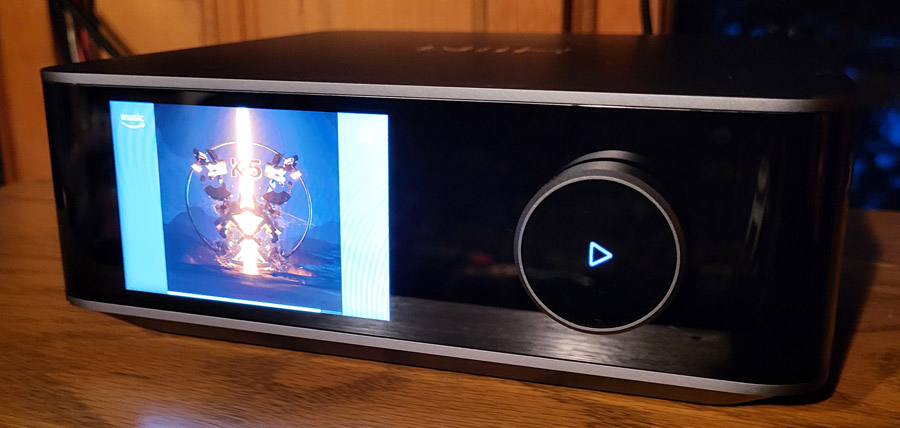
What Is It?
It can go by many names: network streamer, music streaming player or network streaming audio player. No matter what you call it, it’s a device or source component that plays back digital audio and music. A network streamer normally includes a mobile app to curate various music streaming services and, in most cases, provides access to local digital music files that owners may have ripped from their own CDs or downloaded from music download services.
The WiiM Amp Ultra is what’s known as a “powered streamer,” an “amplified network streamer,” a “powered music streaming player,” or simply a “network amp.” It offers all the features of a traditional music streamer but adds a built-in power amplifier, allowing it to drive virtually any pair of passive loudspeakers directly.
The WiiM Amp Ultra is designed to bring all your digital and analog music sources together and play them back through a standard pair of speakers. HiFi aficionados can think of it as an integrated amplifier, but with support for music streaming services and networking built in.
The WiiM Amp Ultra supports music streaming services and channels such as Spotify, Qobuz, TIDAL, Radio Paradise, TuneIn, iHeartRadio, Amazon Music and more. You can also access local digital music files you may have downloaded or ripped from your CD collection. Digital audio files can be accessed through WiiM’s USB media library feature – just connect a USB drive to the USB port on the back and browse your music files directly. Additionally, the WiiM Amp can access music shared from media servers (DLNA and Samba) on your home network through the “Home Music Share” feature in the WiiM Home app. The WiiM Amp Ultra is also Roon ready so it works directly with any Roon servers or devices in your home network.
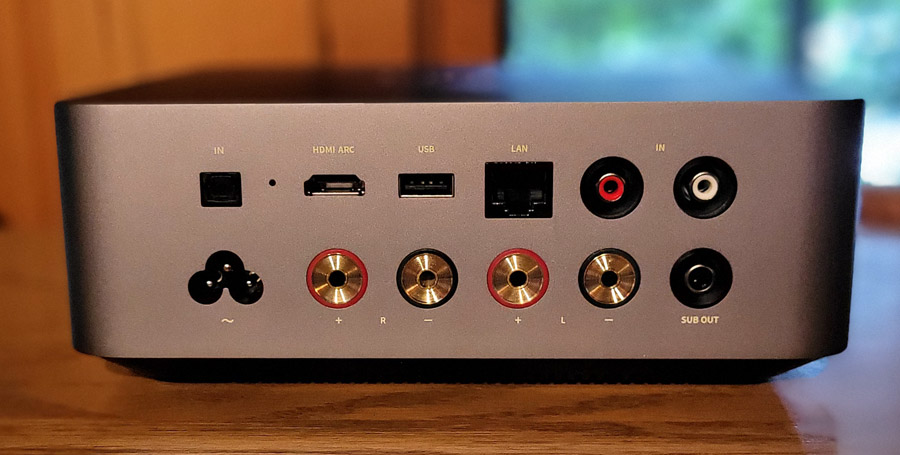
The Amp Ultra includes a fiberoptic digital input for connection of a CD player or other digital source as well as a pair of analog RCA jacks for connecting a tape deck, turntable (with line level output) or other analog source. It even has an HDMI port with ARC support so you can take your TV sound up a notch.
What makes the WiiM Amp Ultra different from most other streamers (including the WiiM Ultra) is its built in amplifier. This integrated Class D amp can output 100 watts/channel into 8 ohms or up to 200 watts/channel into 4 ohms. This means all you need to add in order to enjoy your music and other content is a standard pair of passive loudspeakers. The speaker outputs are flush terminals that only accept a banana plug. WiiM Provides a pair of gold-plated banana plugs in the box. The Amp Ultra even includes a subwoofer output so you can augment the bass of a pair of bookshelf speakers or small towers.
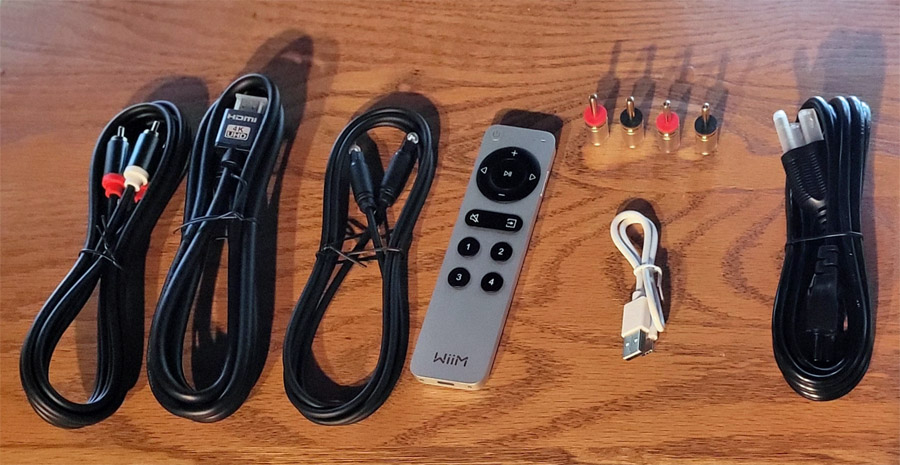
WiiM Ultra vs. WiiM Amp Ultra – What’s the Same and What’s Different?
It would be tempting to just say that the WiiM Amp Ultra is a WiiM Ultra with a built-in amp added, but this wouldn’t be entirely accurate. In aesthetic appearance and in operation, the two devices are nearly identical. But there are a few things missing from the WiiM Amp Ultra which are present on the unamplified WiiM Ultra.
The most notable omissions on the WiiM Amp Ultra are a phono preamp and a wired headphone output. You can connect a turntable to the Amp Ultra but it needs to be a turntable with a built-in phono preamp or you’ll need an external phono preamp. As for headphone connection, you’ll have to rely on either the Amp Ultra’s Bluetooth wireless output or the unit’s USB digital output, but few headphones support USB digital inputs. That USB output could be connected to a separate headphone amp if desired.
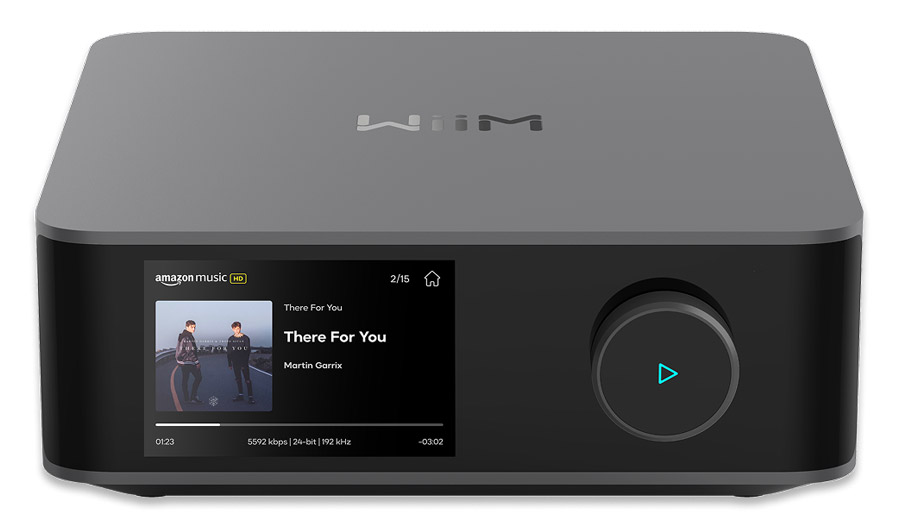
In fact, the Amp Ultra lacks any sort of analog line level output or standard fiberoptic or coax digital outputs so using it as a source device for an existing A/V system or with an external power amp is not really an option. But if you already have an amp you like, then there’s always the current WiiM Ultra. And if you want a more full-featured and flexible platform, you can pair a WiiM Ultra with a WiiM Vibelink Amp for greater functionality and similar performance (at about $100 more than the standalone Amp Ultra for the pair).

In physical appearance, both the Ultra and the Amp Ultra are housed in an elegant brushed aluminum chassis with a high quality 3.5″ glass-covered capacitive touchscreen on the left and a smooth multifunction rotary knob on the right. The WiiM Ultra includes a headphone jack on the bottom right of the front panel while the Amp Ultra lacks a headphone output. The aluminum Voice Remote 2 included with the Amp Ultra is larger and beefier than the plastic Voice Remote which comes with the WiiM Ultra.
The WiiM Ultra measures in at 8.3″ x 2.83″ x 7.87″ (211 x 72 x 200 mm) while the Amp Ultra is actually slightly narrower and almost imperceptibly taller and deeper at 7.9” x 2.9” x 7.9” (200 x 75 x 200 mm). The built-in amplifiers on the Amp Ultra add about 2.3 pounds bringing it up to 5.4 pounds (2.45 kg) compared to 3.13 lbs (1.42 kg) for the WiiM Ultra.
Operationally, the Amp and Amp Ultra are virtually identical. Both offer 10 band EQ and AI-based room correction functionality. The same streaming services are supported by both units, both in the WiiM Home app and via direct connections including Qobuz Connect, AlexaCast, Tidal Connect, Spotify Connect and Google Cast. Both units can be controlled via the integrated touchscreen, the remote control or the WiiM Home app.
One thing missing from both the WiiM Ultra and the WiiM Amp Ultra is support for Apple AirPlay 2. Also, Apple Music is not currently one of the streaming services integrated into the WiiM Home app. Prior to the WiiM Ultra and WiiM Amp Pro, the company previously included AirPlay 2 support in all of its streaming products. The company has told us that adoption of that feature was never very high (around 10% to 11%) so they opted to omit AirPlay support moving forward. Apple users who use Apple Music will need to use Bluetooth or Google Cast from their phone, tablet or MacBook in order to connect to the WiiM Amp Ultra. Other music sources can be accessed by Apple users with the WiiM Home app for iOS.
The Set-Up
Setting up the WiiM Amp Ultra is pretty straightforward. You’ll need to download the WiiM Home app for Android or iOS and then add the device to the Home app. The app will prompt your for some details such as network credentials and will notify you if there are any firmware updates available for the device.
If you’ve already got a WiiM device set up in your home, then all the music sources you have added to the Home app will be available here immediately. If this is your first WiiM streaming product, you’ll need to add whichever streaming services you use so that they can be accessed by the WiiM Home app. Alternatively you can use the “connect” feature of select apps (Qobuz, Spotify, TIDAL) or Google Cast in order to cast the audio from your chosen app directly to the Amp Ultra. The WiiM Amp Ultra supports 2-way Bluetooth 5.3 as well (send or receive) so, in a pinch, you can connect your phone or tablet this way, or use the WiiM Amp Ultra to drive a pair of Bluetooth headphones.

Like Sonos, and HEOS, WiiM allows you to set-up multiple rooms or zones in your home and each can play separate music or they can be synched to all play the same music. The WiiM Home app also includes access to the room correction feature which uses your phone’s or tablet’s microphone to correct for room or speaker anomalies using equalization (more on that later).
If you’re using a WiiM Amp Ultra with a TV, just plug an HDMI cable between the WiiM and the TV’s HDMI ARC/eARC port and all audio output from your TV will be sent to the WiiM Amp Ultra. I tested this and found that it worked as expected connecting a Sony BRAVIA 8 II TV to the WiiM, playing back movies and TV shows in high-quality stereo sound. There is a WiiM feature currently in beta testing called “WiiM Home Theater” that allows you to set up a 5.1-channel surround system using multiple WiiM players and amplifiers, but I was unable to test this as I only had the one WiiM device on hand during testing.
Operationally Speaking
For the most part, operation of the Amp Ultra, either through the WiiM Home app or through the native connect apps, is pretty intuitive. Those who prefer using their native apps like Spotify, TIDAL and Qobuz will appreciate the Amp Ultra’s support for Spotify Connect, TIDAL Connect, Qobuz Connect and even Alexa Cast. “Connect” functionality allows you to take advantage of the full feature set in each native streaming app and simply choose the WiiM Amp Ultra as the playback device.
This “Connect” feature bypasses the phone entirely as far as the music is concerned. It sends the digital audio stream directly from the cloud to the Amp Ultra. The phone is then freed to just be the control device. On TIDAL, Amazon Music and Qobuz, this means you get full lossless and even hi-res audio support and none of the losses or interruptions involved with Bluetooth streaming. And once you’re casting to the Amp Ultra you can use the WiiM remote or the touch screen to navigate through your music and you’ll see things like album art, artist and track details on the Amp Ultra’s integrated screen.
Similarly, apps like Radio Paradise can take advantage of Google Cast (formerly known as Chromecast) to stream to the Amp Ultra via WiFi, again with full support for lossless audio playback.

However, not everything was perfect in WiiM-land. I noticed some inconsistencies in connectivity, including trying to use Amazon Music and Radio Paradise to cast my podcasts and playlists from my phone to the Amp Ultra. It didn’t work at all, until I specifically enabled Google Cast in the WiiM Home app set-up menu, which apparently has to be done for each individual WiiM device. There is no setting within the Amp Ultra itself to enable Google Cast. It can only be done in the mobile app. When I asked about this, a WiiM rep told me the ability to enable Google Cast on the device itself is something they’re considering for an upcoming software update.
I did enable Google Cast in the app and was initially able to cast from my phone’s Amazon Music app to the Amp Ultra. But it just randomly stopped working during a listening session – the device could no longer be found in the device list in the Amazon app. It appeared again in a later session, but I was not able to adjust the volume in the Amazon app. I had to adjust it on the device itself or using the WiiM Remote.
Apps like Radio Paradise (which also uses Google Cast) worked reliably. I was also able to load Amazon Music within the WiiM Home app and cast to the device that way, but this wasn’t as convenient as a direct connection from the native Amazon Music app. And the Amazon Music app within WiiM Home does not seem to support podcasts, just music, so that limited things a bit.
Update (August, 2025) – with a later software update, I found that I was able to connect more reliably from Amazon Music to the WiiM Amp Ultra using Alexa Cast. This way, I was able to use all of the functionality of the Amazon Music app (including podcasts), and deliver my music to the Amp Ultra in lossless and high resolution quality. If owners notice reliability issues connecting from Amazon Music, be sure you have enabled the WiiM device in the Amazon Alexa app and you have installed the latest firmware on the WiiM Amp Ultra.
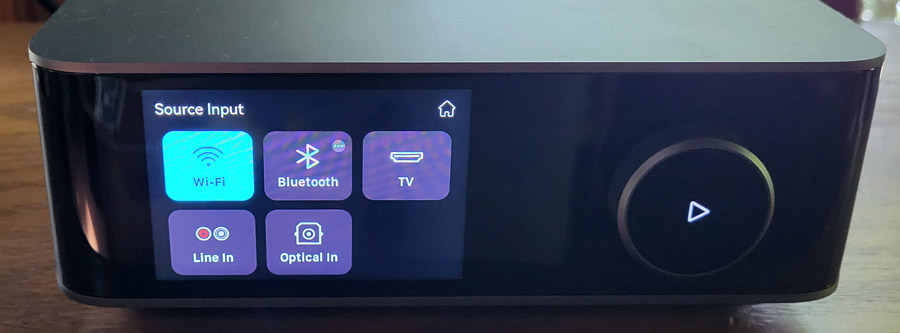
Another odd little idiosyncrasy of the system is that when you hit the “Input” option on the WiiM Amp Ultra home menu, there is no “USB” input option, even if you have a USB thumb drive plugged in. In order to play music back from a connected USB drive, you need to access the USB input from the WiiM Home app. There you’ll have the option to add any songs on the USB drive to your music library. It would be simpler if the device’s own input list showed any connected USB drive as an available source.
We’re Listening
Minor operational oddities aside, what’s important is how the WiiM Ultra Amp sounds. The unit features an audiophile grade ESS ES9039Q2M SABRE DAC (Digital Analog Converter), dual TI TPA3255 Class D amplifiers and six TI OPA1612 op-amps, combined with Post Filter Feedback (PFFB) technology to deliver clean detailed sound across various speaker loads. The Class D amps are rated for 100 Watts/Channel into 8 ohms and 200 Watts/Channel into 4 ohms.
The WiiM Amp Ultra supports high-resolution audio files and streaming up to 24-bit/192kHz. It can also handle higher resolution files via its USB-C output, up to 32-bit/384kHz PCM and DSD512, but then you’d need an external DAC and amplifier. The WiiM Amp Ultra does support DSD file playback from a connected USB drive or DLNA server but it converts the DSD files to PCM 24-bit/192kHz for playback.
I listened to lossless and high resolution music from Amazon Music Unlimited, Qobuz and Radio Paradise. I also loaded up a USB drive with high resolution audio files downloaded from HD Tracks and digital rips from my CD collection. I even connected a TV via HDMI/ARC and watched a few movies and TV shows through the system.
I auditioned the WiiM Amp with a couple of different pairs of budget bookshelf speakers: the MartinLogan B1 speakers ($699.98/pair MSRP) and the Vera-Fi Vanguard Scout ($299/pair). Both speakers proved to be an excellent match for the WiiM Amp Ultra with solid imaging, natural tonal balance and nice dynamic range.

The MartinLogan B1’s are rated at 89 dB sensitivity and a nominal impedance of 5 ohms. The Vera-Fi Vanguard Scout speakers are a bit less efficient at 84.5 dB, with a nominal impedance of 8 ohms. With either set of speakers, the WiiM Amp Ultra presented a deep soundstage with nice air and detail in the treble as well as natural sounding male and female vocals. And the Amp Ultra was able to drive either system to levels which filled my little mountain cabin with dynamic sound and likely even annoyed (or entertained?) those on the other side of the lake. It was that loud.
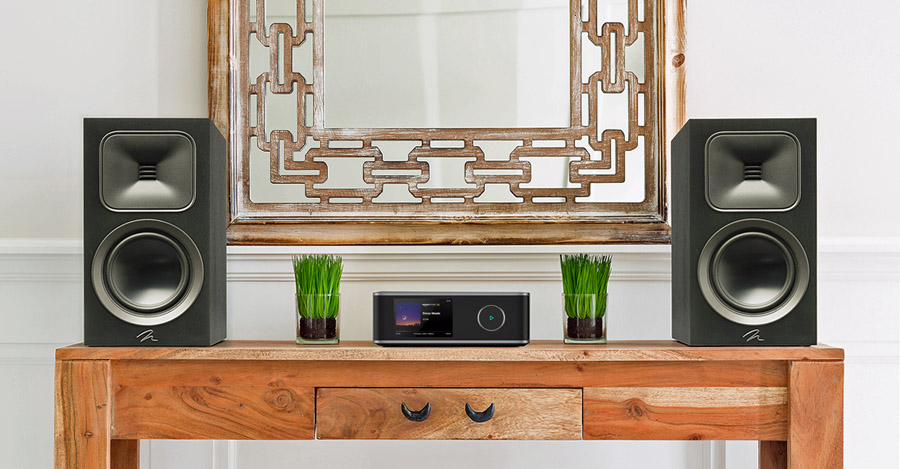
The bass response on these bookshelf speakers is not very extended. The Scouts are rated down to 45 Hz (with no tolerance or deviation listed), but I didn’t really hear much below 60 Hz. The larger MartinLogan B1s are rated 48 Hz – 23,000 Hz (±3dB) and they did present more solid and extended bass, but still not much in the lowest octaves.
The Amp Ultra was more than capable at squeezing every last drop of bass out of either set of speakers. But if you like to listen to EDM, rock or even jazz or classical and like to really hear (and feel) those lowest octaves of the synth, bass drum, upright bass and piano, you’ll either want to try a pair of tower speakers or add a powered subwoofer. I chose the latter option, adding Vera-Fi’s ultra budget Vanguard Caldera 10″ powered subwoofer ($199).
The WiiM Amp Ultra allows you to either manage the bass in the WiiM Home app (crossover, phase, level, EQ) or pass the signal full-range out of the subwoofer output so you can do bass management on the subwoofer instead. I got excellent results using the WiiM app to manage the bass so didn’t feel a need to explore bypassing its bass management.
Adding the Vera Fi subwoofer to the bookshelf speakers via the Amp Ultra’s subwoofer output transformed the sound from a polite, elegant and refined little budget HiFi into a beast of a system capable of blasting the synth bass tracks of deadmau5 with a guttural punch and reproducing smaller orchestral pieces with aplomb. As far as budget speaker systems go, for just under $500, the Vera Fi Caldera Scout and Vanguard Caldera 10″ sub combo is hard to beat.
The MartinLogan B1 bookshelf speakers were no slouch either, particularly when supplemented by the Vera-Fi subwoofer. Treble response was smoother and a bit less strident than the Caldera Scouts, and high frequencies had an airy lightness thanks to the AMT (Air Motion Transformer) tweeters. Imaging on the B1s was also excellent through the WiiM Amp Ultra. And with their higher sensitivity, the WiiM/MartinLogan system was capable of even greater dynamic range and higher SPLs than the WiiM/Vera-Fi pairing. MartinLogan appears to agree on that WiiM match as they sell a bundle with the B1s and the lower-powered WiiM Amp amplified streamer on their web site.
Correction Corner
Like virtually all of WiiM’s current products, the Amp Ultra also offers a room correction feature to optimize the sound for your specific speakers and room. When initially launched, the only option was to use your phone’s microphone for this. But now WiiM allows the use of an external microphone as well as a microphone calibration file to get more accurate results. This is just one of many new features and feature improvements WiiM has made to their products over time.
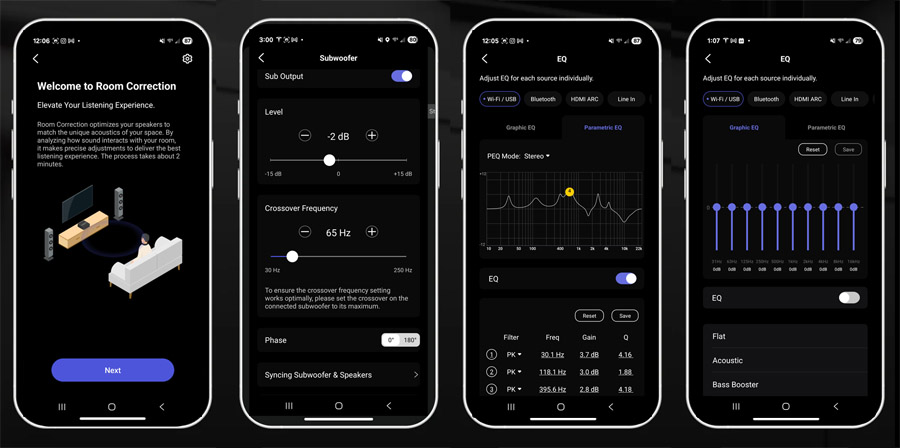
I tested WiiM’s room correction using the mic built into my Samsung Galaxy S21FE phone and found that it was effective at taming some excessive high frequency energy in my rather live listening room. But I did have to do some manual tweaking of the Parametric EQ curve for best results. WiiM allows you to adjust frequencies either via a graphic or parametric EQ (10 bands) and allows you to save up to 12 custom EQ presets. This was plenty for me even when testing multiple speakers and speaker/subwoofer combinations. For details on how to set up WiiM Room correction, check out this tutorial on the WiiM web site.
The Bottom Line
While I can’t say I’m a fan of the omission of the headphone out, phono in and line level outs (compared to the WiiM Ultra), and the lack of AirPlay and native Apple Music support may limit its appeal to fans of Apple’s ecosystem, there’s a lot to like about the WiiM Amp Ultra. I appreciated its high quality color touch screen, generous amplification power, flexible EQ, room correction and customization parameters as well as its dynamic yet refined sound. When paired with a capable pair of speakers, the WiiM Amp Ultra provides virtually all a music fan could want in a budget HiFi stereo system: robust features, excellent sound quality, intuitive operation and access to nearly all of the popular music streaming services.
If you want a little more flexibility, consider pairing the unpowered WiiM Ultra with WiiM’s VibeLink Amp, but then you’ll have the added complexity of a second box. For a single-box powered streaming solution, you can’t go wrong with the WiiM Amp Ultra. Highly recommended.
Pros:
- Feature-packed streamer puts more expensive options to shame
- Competent built-in amplifier can drive most speakers effectively
- Supports multi-room/multi-zone audio
- Supports Hi-Res Audio from numerous sources as well as local digital files
- WiiM adds new features and fixes via regular software updates
- Color screen allows you to see song and album info and artwork and navigate your playlists or presets without having to check your phone
- Excellent price/performance ratio
Cons:
- No phono input
- No headphone or other analog output
- No AirPlay 2 support
Where to buy:
Related Reading:

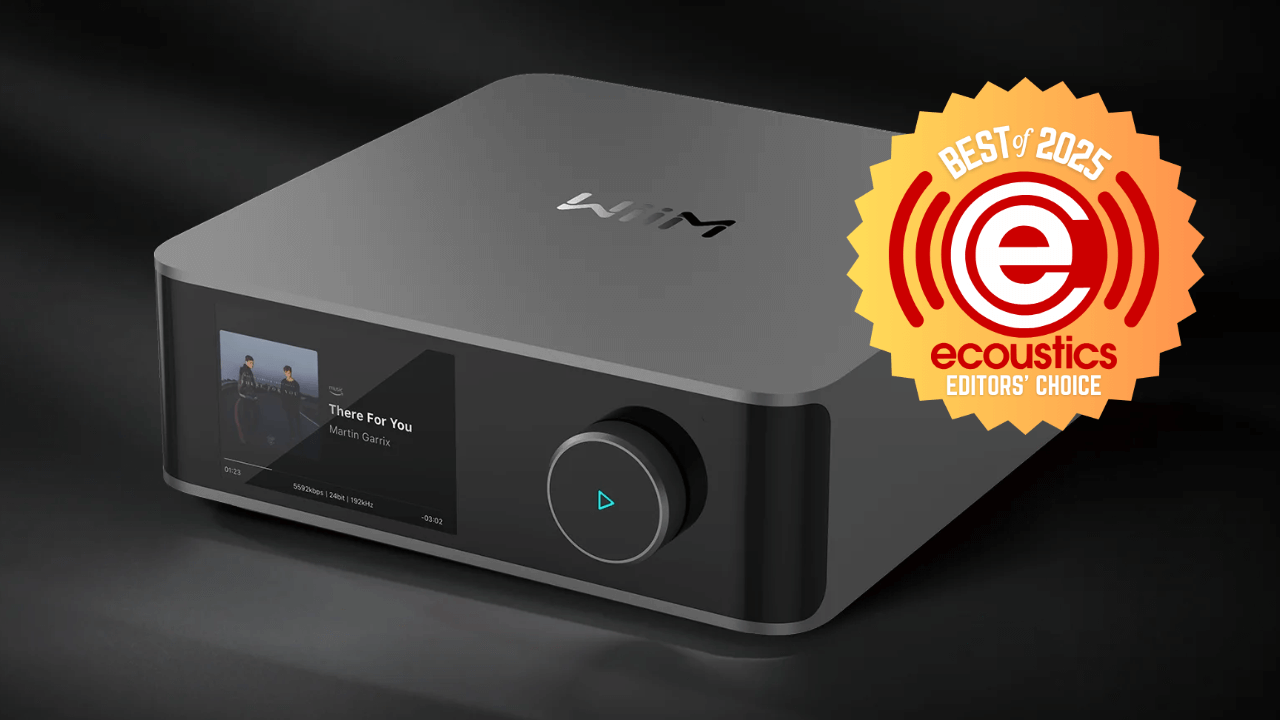



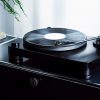









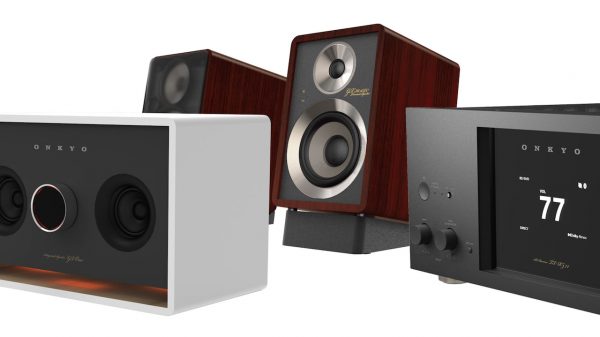
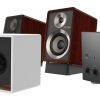







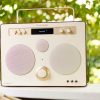











Catherine Lugg
July 25, 2025 at 3:02 pm
Thank you for this DETAILED review. Now, I’ll have some decisions to make between the soon-to-be released Bluesound Powernode (2025) and this little beast of an amp. Thank you, again!
Ian White
July 25, 2025 at 5:41 pm
Catherine,
The Bluesound will definitely have a very different tonal balance and fewer features.
I’m a fan of both brands and own their products. It will come down to which OS and app you prefer and the speakers you plan on using.
Chris Boylan
July 25, 2025 at 5:40 pm
You’re welcome, Catherine. Don’t forget the Eversolo Play. That one looks promising too! 🙂
Ian White
July 25, 2025 at 6:23 pm
And it comes with an internal CD player.
IW
Burnside
July 26, 2025 at 4:31 pm
Are you unaware of AlexaCast which all WiiMs support which can provide 24/192 bit perfect casting from the Amazon Music app rather than Chromecast which only supports up to 16/44.1 from that app?
Chris Boylan
July 28, 2025 at 9:48 pm
I’m aware of AlexaCast. If it had been working then the WiiM Amp Ultra should have shown up as an available device in Amazon Music, which it did not, even though I had already linked my Amazon Music account in the WiiM Home app. Once I enabled Google Cast in the WiiM Home App for the Amp Ultra, then Amazon Music was able to see the WiiM Amp Ultra as an available device, so, at that point, I assumed it was using Google Cast for the connection.
But as I mentioned in the review, accessing the WiiM Amp Ultra from within Amazon Music was unreliable. It may be related to the fact that we have two separate households (a main home and a second home where I am testing the Amp Ultra). I know Philips Hue is practically impossible to use with Alexa in a second household unless you actually use a second (separate) Amazon Account for the Alexa account in the second home. It’s possible this situation is similar to that. Or it could be something different. The sample I have of the Amp Ultra is an early one and it has already had a couple of new firmware updates since I first started testing it.
I had a few questions into the WiiM tech folks about connectivity issues with Amazon but they still haven’t followed up on those, so we decided to publish the review rather than waiting an indefinite amount of time for answers. If I get those questions answered and get it working more reliably with Amazon Music, I will update the review accordingly.
Ant
July 27, 2025 at 11:16 am
I’m really confused why you used Google Cast for Amazon Music,rather than AlexaCast?
Chris Boylan
July 28, 2025 at 9:52 pm
See earlier reply to a similar comment. The WiiM Amp Ultra did not show up as an available device in Amazon Music until I enabled Google Cast in the WiiM Home app. Whether that was because of a bug in my early review sample, or something else was going on, I didn’t use AlexaCast because Amazon Music couldn’t find the Amp Ultra as an available device in the network.
If/when WiiM replies to my questions about this and we can get it working reliably, I will update my review as is appropriate.
artatgray
August 24, 2025 at 6:42 pm
Just a quick FYI: these devices are referred to as streaming integrated amplifiers.
I order the Amp Ultra for myself last night and should have it by Friday.
Ian White
August 24, 2025 at 7:48 pm
Art,
They’re not actually referred to as that. Not by any brand we know.
Network or Streaming Amplifiers.
Best,
IW
artatgray
August 30, 2025 at 6:34 am
Perhaps we run in different circles because the term has been used by engineers for a number of years to describe this category of product that integrates a preamp, amplifier, and network player all together in one enclosure.
What brands do to differentiate themselves with naming is purely marketing.
Ian White
August 30, 2025 at 11:52 pm
Art,
Very possible. It’s definitely a marketing term but also how people search for them online.
IW